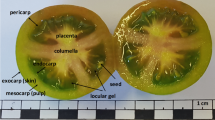Abstract
Cucurbitacins are a group of tetracyclic triterpenes produced by members of the Cucurbitaceae family that are known for their bitter taste, and have both positive and negative attributes based on their use. The aim of the present study was to profile cucurbitacins through the quantitative analysis of diverse watermelon (Citrullus spp.) germplasms, including Citrullus colocynthis and Citrullus lanatus, using liquid chromatography–mass spectrometry (LC–MS) and high performance liquid chromatography. We isolated cucurbitacins B and E, and cucurbitacin E glycoside and evaluated the concentration of these compounds in watermelon leaves, fruits, and seedling extracts. High amounts of cucurbitacin E glycosides were found in most of the C. colocynthis leaves at concentrations between 1.3 and 0.9 mg/g of fresh weight, while relatively low concentrations of cucurbitacin B and E were detectable in these tissues. Interestingly, cucurbitacin E glycosides were only detected in most C. colocynthis fruits at concentrations between 0.21 and 3.2 mg/g fresh weight. We also confirmed the correlation between bitter taste and cucurbitacin E glycoside content. Cucurbitacin B and E and cucurbitacin E glycoside were found in most of the cultivars tested, while cucurbitacin agylcones were the primary cucurbitacins identified in seedlings. This study reveals the cucurbitacin composition in various watermelon germplasms and in different plant tissue.





Similar content being viewed by others
References
Amamou F, Bouafia M, Chabane-Sari D, Meziane RK, Nani A (2011) Citrullus colocynthis: a desert plant native in Algeria, effects of fixed oil on blood homeostasis in Wistar rat. J Nat Prod Plant Resour 1:1–7
Asyaz S, Khan FU, Hussain I, Khan MA, Khan IU (2010) Evalution of chemical analysis profile of Citrullus colocynthis growing in Southern area of Khyber Pukhtunkhwa, Pakistan. World Appl Sci J 10:402–405
Chambliss OL, Erickson HT, Jones CM (1968) Genetic control of bitterness in watermelon fruits. Proc Am Soc Hortic Sci 93:539–546
Chawech R, Jarraya R, Girardi C, Vansteelandt M, Marti G, Nasri I, Racaud-Sultan C, Fabre N (2015) Cucurbitacins from the leaves of Citrullus colocynthis (L.) Schrad. Molecules 20:18001–18015
Chen JC, Chiu MH, Nie RL, Cordell GA, Qiu SX (2005) Cucurbitacins and cucurbitane glycosides: structures and biological activities. Nat Prod Rep 22:386–399
Davidovich-Rikanati R, Shalev L, Baranes N, Meir A, Itkin M et al (2015) Recombinant yeast as a functional tool for understanding bitterness and cucurbitacin biosynthesis in watermelon (Citrullus spp.). Yeast 32:103–114
Delazar A, Gibbons S, Kosari AR, Nazemiyeh H, Modarresi M, Nahar L, Sarker SD (2006) Flavone C-glycosides and cucurbitacin glycosides from Citrullus colocynthis. Daru 14:109–114
Gry J, Soborg I, Andersson C (2006) Cucurbitacins in plant food. TemaNord 2006:556
Guo S, Zhang J, Sun H, Salse J et al (2013) The draft genome of watermelon (Citrullus lanatus) and resequencing of 20 diverse accessions. Nat Genet 45:51–58
Gurudeeban S, Satyavani K, Ramanathan T (2010) Bitter apple (Citrullus colocynthis): an overview of chemical composition and biomedical potentials. Asian J Plant Sci 9:394–401
Gurudeeban S, Ramanathan T, Satyavani K (2011) Characterization of volatile compounds from bitter apple (Citrullus colocynthis) using GC-MS. Int J Chem Anal Sci 2:108–110
Hatam NAR, Whiting DA, Yousif NJ (1989) Cucurbitacin glycosides from Citrullus colocynthis. Phytochemistry 28:1268–1271
Herrington ME, Brown PJ, Carr AR (1986) Introgression as a source of bitterness in Watermelon. HortScience 21:1237–1238
Hussain AI, Rathore HA, Sattar MZA, Chatha SAS, Sarker SD, Gilani AH (2014) Citrullus colocynthis (L.) Schrad (bitter apple fruit): a review of its phytochemistry, pharmacology, traditional uses and nutritional potential. J Ethnopharmacol 155:54–66
Hutt TF, Herrington ME (1985) The determination of bitter principles in zucchinis. J Sci Food Agric 36:1107–1112
Kamboj A, Kaur R, Jain UK, Saluja AK et al (2016) Quantitative estimation of cucurbitacin E in various extracts of cucumis sativus L. by spectrometric method. J Res. Ayurveda Pharm 7:114–122
Koul O (2008) Phytochemicals and insect control: an antifeedant approach. Crit Rev Plant Sci 27:1–24
Levi D, Willner D, Merenlender Z (1964) Constituents of Citrullus colocynthis (L.) Schrad. Phytochemistry 3:1096–1101
Levi A, Thomas CE, Wehner TC, Zhang XP (2001) Low genetic diversity indicates the need to broaden the genetic base of cultivated watermelon. HortScience 36:1096–1101
Metcalf RL, Metcalf RA, Rhodes AM (1980) Cucurbitacins as kairomones for diabroticite beetles. Proc Natl Acad Sci Biol 77:3769–3772
Miro M (1995) Cucurbitacins and their pharmacological effects. Phytother Res 9:159–168
Navot N, Sarfatti M, Zamir D (1990) Linkage relationships of genes affecting bitterness and flesh color in watermelon. J Hered 81:162–165
Qureshi R, Bhatti GR, Memon RA (2010) Ethnomedicinal uses of herbs from northern part of Nara Desert, Pakistan. Pak J Bot 42:839–851
Shang Y, Ma Y, Zhou Y, Zhang H, Duan L, Chen H, Zeng J, Zhou Q, Wang S, Gu W, Liu M, Ren J, Gu X, Zhang S, Wang Y, Yasukawa K, Bouwmeester HJ, Qi X, Zhang Z, Lucas WJ, Huang S (2014) Biosynthesis, regulation, and domestication of bitterness in cucumber. Scinece 346:1084–1088
Shawkey AM, Rabeh MA, Abdellatif AO (2014) Biofuntional moleculs from Citrullus colocynthis: an HPLC/MS analysis in correlation to antimicrobial and anticancer activities. Adv Life Sci Technol 17:51–61
Tallamy DW, Stull J, Ehresman NP, Gorski PM, Mason CE (1997) Cucurbitacins as feeding and oviposition deterrents to insects. Environ Entomol 26:678–683
Teuscher E, Lindequist U (1994) Triterpene. In: Biogene grift-biologie, chemie, pharmakologie, vol 2. Auflage. Gustav Fischer Verlag, Stuttgart, Jena, pp 159–175
Whitaker TW, Davis GN (1962) Cucurbits botany, cultivation and utilization. Interscience Publishers, New York
Acknowledgments
The authors are grateful to Dr. Joung-Hwan Lee for helpful discussion and for critical reading of the manuscript. This work was supported under the framework of an international cooperation program (NRF-2015K2A2A2001928) and basic science research program (NRF 2017R1D1A1A02018460) funded by the National Research Foundation of Korea and the Natural Science Foundation of China (NSFC-31511140284) for S LEE and HF LIU, respectively.
Author information
Authors and Affiliations
Corresponding author
Electronic supplementary material
Below is the link to the electronic supplementary material.
Rights and permissions
About this article
Cite this article
Kim, YC., Choi, D., Zhang, C. et al. Profiling cucurbitacins from diverse watermelons (Citrullus spp.). Hortic. Environ. Biotechnol. 59, 557–566 (2018). https://doi.org/10.1007/s13580-018-0066-3
Received:
Revised:
Accepted:
Published:
Issue Date:
DOI: https://doi.org/10.1007/s13580-018-0066-3




